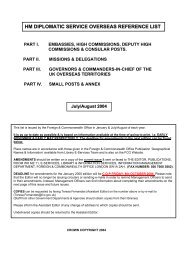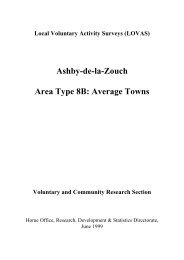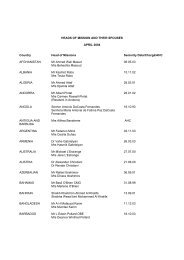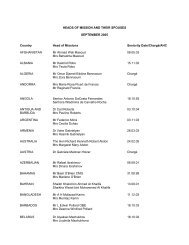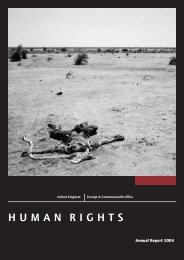A detailed guide to State Pensions for advisers and others
A detailed guide to State Pensions for advisers and others
A detailed guide to State Pensions for advisers and others
Create successful ePaper yourself
Turn your PDF publications into a flip-book with our unique Google optimized e-Paper software.
24<br />
How <strong>to</strong> qualify <strong>for</strong> Home Responsibilities Protection?<br />
To qualify <strong>for</strong> Home Responsibilities Protection in a given tax year since 1978,<br />
a person must have:<br />
• been awarded Child Benefit throughout the year <strong>for</strong> a child aged under 16;<br />
• regularly spent 35 hours a week throughout the year looking after a person who<br />
received Attendance Allowance, Constant Attendance Allowance or the middle<br />
or highest care components of Disability Living Allowance <strong>for</strong> at least 48 weeks<br />
in the year;<br />
• got Income Support throughout the year <strong>and</strong> did not need <strong>to</strong> look <strong>for</strong> work<br />
because they were caring <strong>for</strong> a disabled person;<br />
• been an approved foster parent throughout the year from 2003; or<br />
• had a combination of some of the above circumstances apply <strong>to</strong> them.<br />
It can help people who do not do any paid work <strong>and</strong> those who do some work but<br />
do not have enough earnings in the tax year <strong>to</strong> make it a qualifying year.<br />
Exclusion from Home Responsibilities Protection<br />
Married women <strong>and</strong> widows cannot get Home Responsibilities Protection <strong>for</strong> any<br />
tax year in which they would be paying married women’s reduced rate National<br />
Insurance contributions if they were working. However, women lose their right <strong>to</strong><br />
reduced liability if <strong>for</strong> any two whole consecutive tax years since 6 April 1978,<br />
they have not had any earnings on which Class 1 National Insurance contributions<br />
needed <strong>to</strong> be paid or treated as paid <strong>and</strong> they have not been self-employed. This<br />
is known as the two-year test. Unless they are sure what their position is, they<br />
should check it with HMRC. They may find that they no longer have reduced<br />
liability <strong>and</strong> so can get Home Responsibilities Protection if they claim it or it may<br />
have been awarded <strong>to</strong> them au<strong>to</strong>matically.<br />
When <strong>to</strong> claim Home Responsibilities Protection<br />
Since April 2002, Home Responsibilities Protection must be claimed within three<br />
years of providing care if a person is caring <strong>for</strong> a sick or disabled person. It is<br />
important <strong>to</strong> regularly let the HMRC know the situation.<br />
People must apply <strong>for</strong> Home Responsibilities Protection <strong>for</strong> each tax year using<br />
<strong>for</strong>m CF411 Home Responsibilities Protection <strong>for</strong>m. This will apply if they are:<br />
• looking after someone who is getting Attendance Allowance, Constant<br />
Attendance Allowance or the middle or highest care component of Disability<br />
Living Allowance;<br />
• covered <strong>for</strong> the whole tax year only by a combination of the qualifying reasons –<br />
<strong>for</strong> example, if their youngest child reaches 16 in August, <strong>and</strong> from August <strong>to</strong><br />
5 April of that tax year they look after someone who is sick or disabled; or<br />
• a foster carer. (They must also enclose a letter from the local authority or<br />
agency which employs them <strong>to</strong> confirm that they have been an approved foster<br />
carer throughout the full tax year.)




